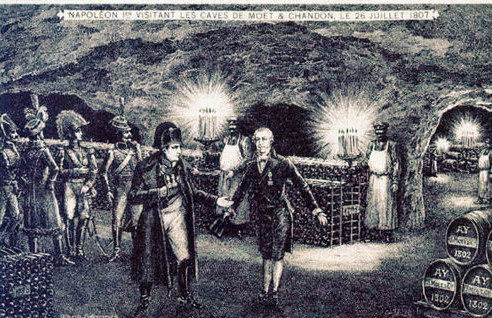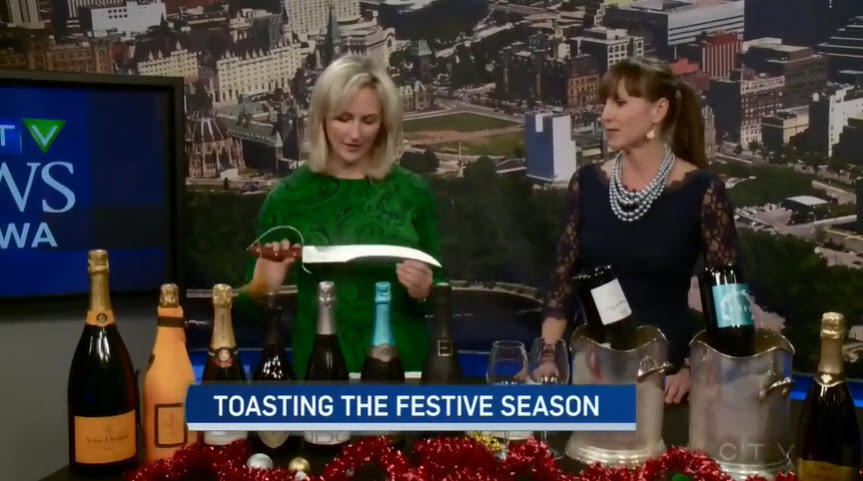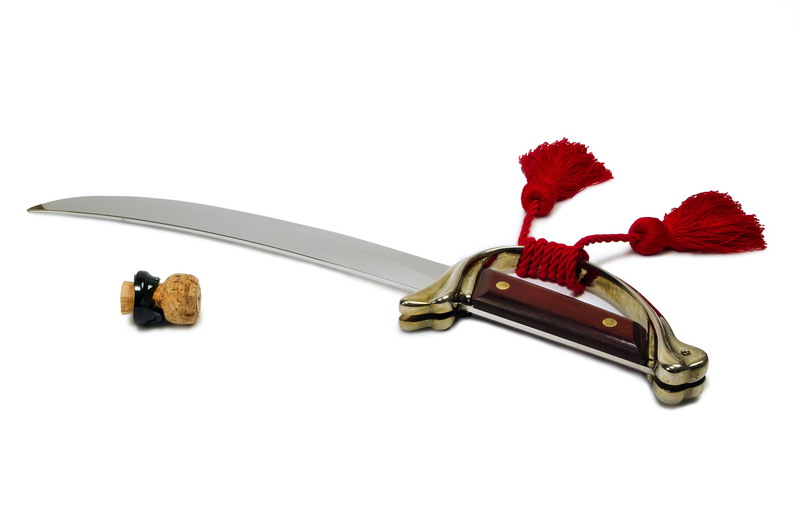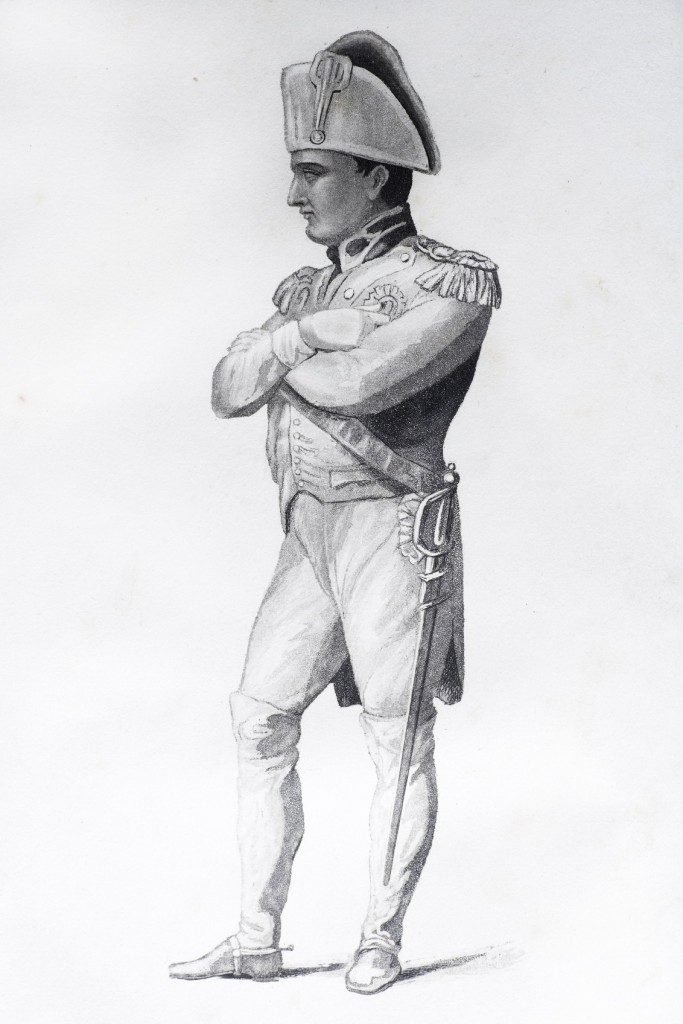Leanne and I chat about sparkling wines and Champagnes for the holidays. Click on the arrow to play the video above.
 Napoléon visits the Moët & Chandon cellars in 1807
Napoléon visits the Moët & Chandon cellars in 1807
Napoleon is credited with inventing the sabering technique and is famous for his phrase:
“In victory we deserve Champagne, in defeat, we need it.”
The famous Champagne maker Veuve Clicquot, who lost her husband when she was just 27, was a wealthy young widow. She would entertain Napoleon’s officers (early day sampling program). They, in turn, tried to impress her by sabering the tops of the Champagne bottles that she gave them.

Show time! In the video above, I attempt to sabre of a bottle of sparkling wine … does it work?
The Science
Unlike still wine that’s fermented once, sparkling wine is fermented a second time to create the bubbles. For both Champagne from France and many other sparkling wines from other regions, this second fermentation happens inside the bottle, trapping the bubbles and creating an internal pressure that’s equivalent to the inside of city bus tires at 90 pounds per square inch (psi).
If your bottle isn’t cold, that pressure increases even more. The diameter of the bottle opening is only 18 millimetres or three-quarters of an inch, so that’s an credible about of force for that bubbly to escape through that narrow opening.
The lip of the bottle, called the annulus (very important to pronounce that correctly ;) creates a stress point, as does the the vertical seam of the bottle where the two halves of the glass were joined together by the glassmaker. It’s a thin, barely visible seam. Where that seam meets the lip is the greatest point of structural weakness for the bottle, and the glass strength is reduced by more than 50%.
Striking this point with your saber creates a crack that rapidly spreads through the glass, exacerbated by the momentum of the saber and the pressure inside the bottle. Once you severe the top of the bottle, the pressure inside and the momentum transferred from the saber sends the cork and glass around it flying, anywhere from 15 to 25 feet.
In the video above, I show you how to open sparkling the “normal” way then how to sabre it, step by step.
How to Sabre Champagne
- Bottle must be drinking temperature cold (not ice cold) at 45-48°F or 7-8°C so that when you open the bottle most of the carbon dioxide stays dissolved in the wine and doesn’t splurt all over the place, leaving you with less champagne.
- At warmer temperatures of 48-60°F or °C or higher, more of the carbon dioxide will spray out of the bottle, which makes a mess and leaves you with flat champagne. That’s because the solubility of carbon dioxide in the wine drops by a factor of 20,000 once you open it if the wine is warm and that cork will be traveling up to 50 miles an hour versus 25 for chilled bubbly because gases travel faster when warmer. There are about 10 million bubbles in a bottle of sparkling wine.
- The fastest way to chill Champagne (and wine) is in a bucket of ice water, but if you’re sabering make sure the neck of the bottle is facing down and completely submerged in the water. If chilling the fridge, use the back of the top shelf, which is the coldest part of the fridge where the cold air outlet is. Warmest places are side door pockets (avoid) which warm up every time you open the fridge.
- Remove the foil and wire basket (muselet) around the cork (bouchon) could impede the sliding movement of the saber.
- Hold the bottle with your thumb inside the punt (bottom indent of the bottle) and fingers around the base. The neck of the bottle faces up and away from you and not pointing at anything that could be broken or injured… think tree ornaments and human eyes.
- Drape a towel over your wrist to catch any wine that escapes (or blood … kidding). Also a chilled bottle is often wet from condensation and a towel will give you extra traction if you need it.
- Place the saber along the bottle’s glass seam (feel with your fingers to find this faint line) with the flat edge facing the neck of the bottle (annulus). We are not slicing the top off with the sharp end, but rather using physics to hit the weakest break point. Plus, we don’t want to dull the sharp edge of the sabre.
- The cork and glass ring around it should fly away in one piece, leaving a fairly clean cut on the neck of the bottle. Napoleon believed the cork represented his friend and he was the surrounding glass: therefore it was a good omen if the piece stayed in tact.
- The internal pressure ensures that no glass gets back into the bottle making it safe to drink. There is no “Shard-onnay” here ;)
- Some bottles don’t saber as well as others: the plastic corks I tried work but are difficult. Then again it could be the cheap bubbly inside the bottle didn’t have enough pressure. Champagne is ideal as the bottles usually have thicker glass.
Please don’t try this at home or anywhere else … call in a professional to do it, like me, especially if the Champagne is top notch ;)
Fun Facts
Guinness Book of World Records: most Champagne bottles sabered in just 1 minute = 47 by Mirko Rainer on 6 September 2014 in Mendrisio, Switzerland.
Most Champagne bottles sabered simultaneously = 487 also in Switzerland the day after Mirko completed his feat.
Veuve Clicquot Brut Champagne 1.5 Litre Magnum
Champagne A.C., France
Veuve Clicquot Brut Champagne
Champagne A.C., France
Dom Pérignon Brut Vintage Champagne
Champagne A.C., France
Veuve Clicquot Vintage Brut Rosé Champagne
Champagne A.C., France
Benjamin Bridge Méthode Classique Brut
Nova Scotia, Canada
Henry of Pelham Cuvée Catharine Blanc de Blanc Carte Blanche
Short Hills Bench, Niagara Peninsula, Ontario V.Q.A., Canada
Wolf Blass Gold Label Sparkling Wine
Adelaide Hills, South Australia, Australia
Oyster Bay Sparkling Cuvée Rosé
Marlborough, New Zealand
Bollinger Special Cuvée Brut Champagne
Champagne A.C., France
Freixenet Elyssia Gran Cuvée Brut Cava
Penedès D.O., Spain
Lily Sparkling Wine
Ontario V.Q.A., Canada
How to Sabre Champagne + Sparkling Wines Video 1
Michael: Let’s go to Leanne, now, who’s just bubbling with excitement with our guest, Natalie MacLean.
Leanne: We have been a bit giddy on this side of the studio but we have yet to open the bubbly.
Natalie MacLean, wine writer extraordinaire, you’re offering us some real lessons on Sparkling wines from all over the world and all price points.
Natalie: Right.
Leann: What does the gal who has everything get herself for Christmas? We held it up twice already.
Natalie: Yes, this is live action as wine gets. I’m feeling a bit swashbuckling … Pirates of the Caribbean. This is a Champagne saber.
Leanne: Natalie has bought herself a saber, and we’re going to show you how to saber wine. You don’t need to buy a saber apparently.
Natalie: No.
Leanne: You see, you can do it with a butter knife.
Natalie: With a butter knife, yes; but this is far more pageantry.
Leanne: May not be for the faint of heart.
Natalie: No.
Leanne: We’re going to that in a short while.
Natalie: Exactly, please don’t do this at home.
Leanne: Let’s start with the Veuve?
Natalie: Okay.
Leanne: You’ve brought along …
Natalie: … over here we have Veuve Clicquot. Veuve means widow because there were a number of Champagne houses, including Veuve Clicquot, at the turn of the century. This young woman – 27 years old with an eight-year-old daughter lost her husband to illness. A lot of women also lost their husbands to war, took over the Champagne houses and built the biggest luxury brands in the world. If you think Bollinger, Taittinger, Laurent-Perrier, they were all young women, at the time, building these brands. So what we have here is the magnum size which is the equivalent of 2 bottles, this just says festive to me, right? It’s saying, let the party begin.
Leanne: That’s quite a hostess gift . You wanted everyone to know the differentiation between the Champagne and a Sparkling wine.
Natalie: Exactly, so Champagne is a trademarked word. Only Sparkling wine from Champagne in France, may be called Champagne. Everything else is Sparkling wine. We have some fine Canadian examples that are made using the same methods as Champagne and use the same grapes … Pinot Noir, Chardonnay Pinot Meunier. Second fermentation in the bottle gives it those bubbles. Here we have about $75, $65, and here we go down to $35.
Leanne: You did skip right over the Dom Pérignon.
Natalie: I did.
Leanne and Natalie: Which is $313.
Natalie: What’s interesting about Dom Perignon is he was a blind monk in an Abbey. Because a lot of the French wines, not just Champagne, but also the still wines, were first cultivated by the monks as a way of earning their living. That’s where the vineyards were. Dom Perignon is a blind monk and he’s credited with inventing Champagne which is almost correct. He didn’t invent the whole putting the bubbles in the bottle but rather the blending of the base wines. His famous statement is “I am drinking the stars.”
Leanne: That’s pretty beautiful.
Natalie: Isn’t that nice?
Leanne: I think as you open the bottle of Dom Perignon, you would feel as you were drinking the stars or at least with stars.
Natalie: Exactly at that price point.
Leanne: But you know, you really want the bubbly and the Sparkling wines to be accessible to everyone and that’s why you brought along some other suggestions.
Natalie: Exactly.
Freixenet Cordon Negro Brut Cava
Penedes, Spain
Leanne: This is a good price point and it’s a Cava.
Natalie: Freixenet, yes. Cava means cave in Spain so all Spanish Sparkling wines are called Cava. Whereas from Italy it’s Prosecco. This is actually dry. The Spumante was a sort of sweet Italian bubbly.
Leanne: And I mentioned to Natalie that I’m not so crazy about the Prosecco because I find it too sweet and you said to look for …
Natalie: They’re dry and earthy. So the Freixenet, the cava from Spain is about $12 – $15. Now we’re really getting into value yet they’re still delicious; especially if you’re planning a big party.
Leanne: If you’re looking for a Prosecco, look for which, to get the dryer one?
Natalie: Yes, well they’re all pretty much a dry style. It’s the Spumante that is more of the sweeter one where they’ve got the grape juice preserved.
Leanne: Now that would be where the Nova Scotian girls really had their first introduction to anything Sparkling. The first time I met Natalie, you made me laugh because you said you’ve come a long way from baby duck.
Ménage à Trois Prosecco
Veneto D.O.C., Italy
Natalie: Baby duck, back at the high school portable … just kidding.
Leanne: So we are going to show you how to open Champagne, saber-wise and the traditional way.
Natalie: Right.
Leanne: I think we’re going have to do that on our next segment.
Natalie: Okay, that’s fine.
Leanne: In the next few seconds, tell us what you brought along on this side of the table.
Natalie: Here’s another one from Ontario … Southwestern Ontario. Her name is Lily and we may just be ‘off with her head’ on the second segment. She’s a lovely bubbly. Then we have some new world ones … Wolf Blass from Australia, Oyster Bay from New Zealand and Trapiche from Argentina. They are all using their native grapes as the base. Whereas these are Chardonnay, Pinot Meunier and Pinot Noir, the Oyster Bay that you’re lovingly touching is made from Sauvignon Blanc. That’s the iconic white wine, that’s the base.
Leanne: And the Oyster Bay’s Sauvignon Blanc is lovely.
Natalie: It’s refreshing and crisp as a bubbly.
Leanne: I’m not certain that Michael is crazy about bubbly, are you Mike?
Michael: You’re right; I’m not crazy about bubbly.
Leanne: Which is maybe the only thing I don’t like about you.
How to Sabre Champagne + Sparkling Wines Video 2

Michael: Leanne and Natalie are making me want to raise a glass.
Leanne: And soon it will be a glass of Champagne. Michael, we will have you converted.
Natalie: We’re determined.
Leanne: You said, every occasion really is an occasion to raise a glass of Champagne.
Natalie: It is. And the Champagnois are such expert marketers, think about it … new baby, new ship, wedding, anniversary, they’re the expert marketers. Back to Veuve Clicquot, she’s the one who got her Champagne through the Napoleonic war blockade. The ships got it to the court of Russia, for the birth of the new Czar and it became fashionable across Europe to toast the birth of a new Monarch with Champagne.
Leanne: She was a powerful woman.
Natalie: I know.
Leanne: A visionary, you could say.
Natalie: Good sampling program, direct mail, she had it all.
Leanne: And you said that you’re surprised when people say and there are a lot of people say “Oh, I really don’t like bubbly” or “I don’t like Sparkling wine” or “I don’t like Champagne.”
Natalie: Right.
Leanne: And you said that’s why?
Natalie: Probably they haven’t had a lot of exposure to it or it could go back to early days … the sweet syrupy stuff. This is dry, it’s refreshing and it’s a swarm of bubbles.
Leanne: That is the misconception we talked about, when you think certain things are too sweet and they’re not actually.
Natalie: Exactly, and they’re not.
Leanne: Now, these are not Champagne flutes but you wanted to talk about …
Natalie: … the shape.
Leanne: The glasses and the shape.
Natalie: This is a white wine glass and it will serve our purpose today but a flute is even more elongated to preserve the bubbles, the liquid beads going up the side. Traditionally a Champagne glass was like a wide cup; it was shaped on Marie Antoinette’s breast. So that was an honour to her but all the bubbles dissipated As they say, “Let them eat cake but don’t drink Champagne out of that glass”. It’s not going to work.
Leanne: We are learning so much. We’re about to actually start to clear the deck. We’ll have our cameraman Mark put his safety glasses on.
Natalie: Well, yes and I’m going to open it the regular way.
Leanne: Regular first.
Natalie: Some people are nervous about opening a bottle of Champagne. All the crew is kind of …
Leanne: … going away. I have complete confidence in you, Natalie, but everyone else should be clearing the studio.
Natalie: You’re still standing fairly close.
Leanne: Yes.
Natalie: Okay, so we take off the foil first and then we take off the wire cage. Six turns will get the wire cage off 4, 5, 6 … it always works. You want to keep your thumb on this so that it won’t pop off , the thing is not to twist the bottle. Get a little bit of a grip because this is a bit slippery, it has some condensation on it. I’m just holding tight and then I’m going to turn the bottle slowly. I can feel the cork, under there, doing a work for me The pressure inside the bottle of a Champagne or a Sparkling wine is 90 lbs./sq. inch That’s the same as the city bus tires. Ready for the pop?
Leanne: Ready for the pop.
Natalie: Here we go and to come up with a sigh.
Leanne: I’m sighing. It’s lovely, okay.
Natalie: There we go.
Leanne: We’ll pour this and give Natalie a bit of a break. And then we’ll saber…
Natalie: Okay, you go ahead and enjoy that.
Leanne: Fabulous, cheers!
Natalie: Cheers!
Leanne: Okay, take a bit of a breather.
Natalie: Okay, next up though, I’m going take out poor Lily here, lovely gal from Southwestern Ontario. It’s another great bubbly and I’ve already taken off the foil but this time we’re going to saber. Now, this is goes back to the Napoleonic era, Napoleon himself always wore the saber right here. Very swashbuckling, didn’t have time for a corkscrew while he’s in battle. Napoleon said famously “In victory we deserve it, in defeat we need it.” … Champagne. So this one has to be cold that’s why had it neck down and we want to find the seam of the bottle, which is where the glass meets the lip.
Leanne: This is important because it’s all about physics.
Natalie: It’s all about physics. We’re not going to actually slice off the top; we’re going to hit it at its weakest structural point.
Leanne: Do we have to worry about the glass going into the liquid?
Natalie: No, we don’t because there’s so much power in this bottle that 90 lbs. coming out, ¾ inch opening that it’s going to shoot everything out; so there’s no “chard-donnay”.
Leanne: Well done.
Natalie: Yes.
Leanne: Natalie, we are going to end our segment with a bang.
Natalie: Okay.
Leanne: Not a whimper but we have about 30 seconds left.
Natalie: I’m excited to do this. So the dull end because it’s all about…
Sorry guys, 1 2.
Leanne: Have a good try. Darn! It’s okay.
Natalie: Let’s see.
Leanne: Go this way. Nicely done!
Michael: Here we go.
Natalie: Three times a charm.
Leanne: Three times a charm. Michael, what do you think?
Posted with permission of CTV.























